PUBH6013: Qualitative Study on Sleep Deprivation and Fertility
VerifiedAdded on 2022/10/01
|11
|2450
|25
Report
AI Summary
This report presents a qualitative study investigating the relationship between sleep deprivation and fertility. The study explores the impact of sleep on reproductive health by analyzing data collected through interviews, questionnaires, and observational methods. The research question focuses on whether there is a significant relationship between sleep deprivation and fertility. The study uses a mixed-methods approach, including semi-structured interviews and document analysis, to gather data from a sample of 30 participants. The findings suggest a correlation between sleep duration and fertility levels, highlighting the importance of adequate sleep for hormone regulation and overall health. The report also discusses the challenges faced during data collection and analysis and concludes with a reflection on the research process. The research emphasizes the need for individuals to prioritize sufficient sleep to prevent infertility and maintain a good quality of life.
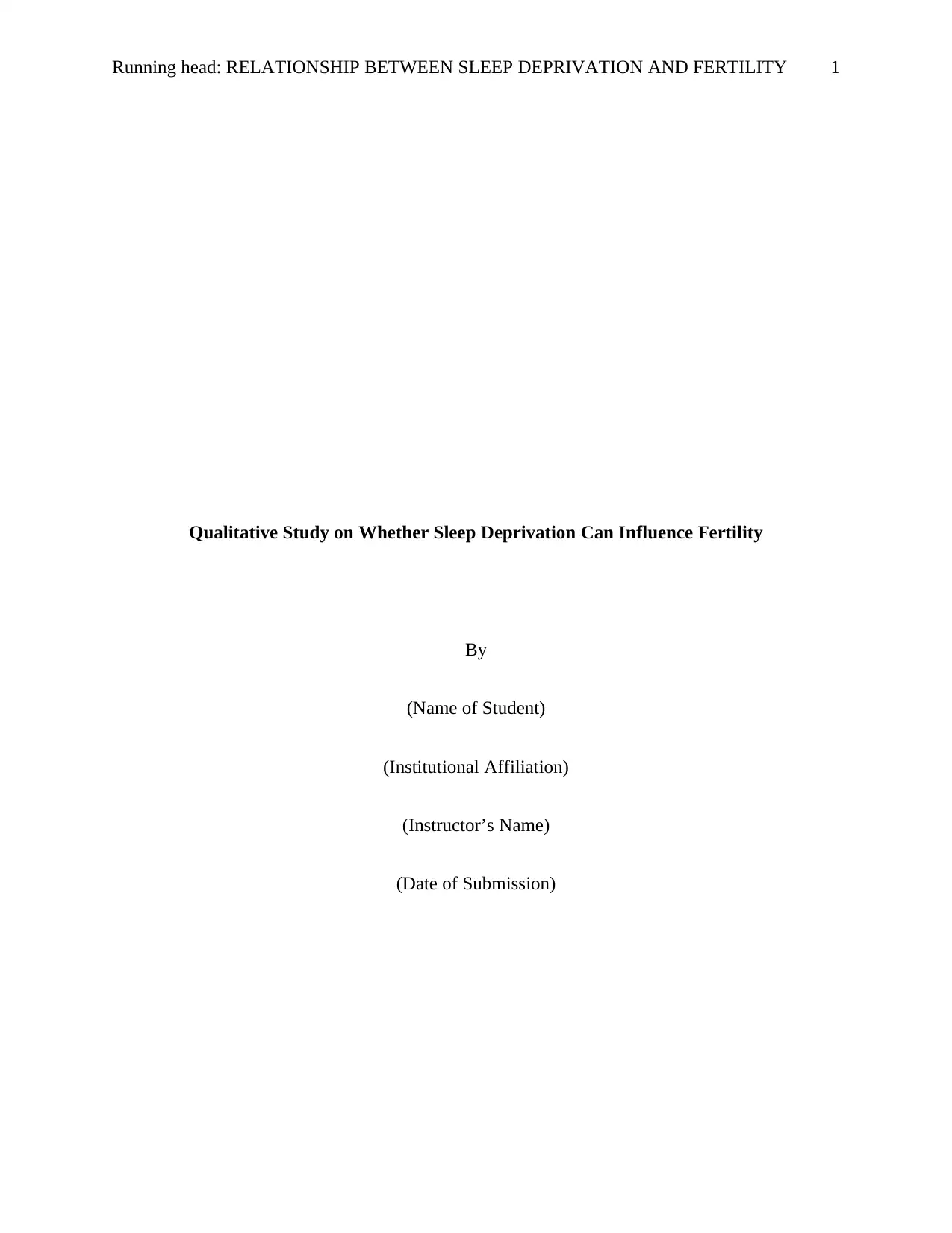
Running head: RELATIONSHIP BETWEEN SLEEP DEPRIVATION AND FERTILITY 1
Qualitative Study on Whether Sleep Deprivation Can Influence Fertility
By
(Name of Student)
(Institutional Affiliation)
(Instructor’s Name)
(Date of Submission)
Qualitative Study on Whether Sleep Deprivation Can Influence Fertility
By
(Name of Student)
(Institutional Affiliation)
(Instructor’s Name)
(Date of Submission)
Paraphrase This Document
Need a fresh take? Get an instant paraphrase of this document with our AI Paraphraser
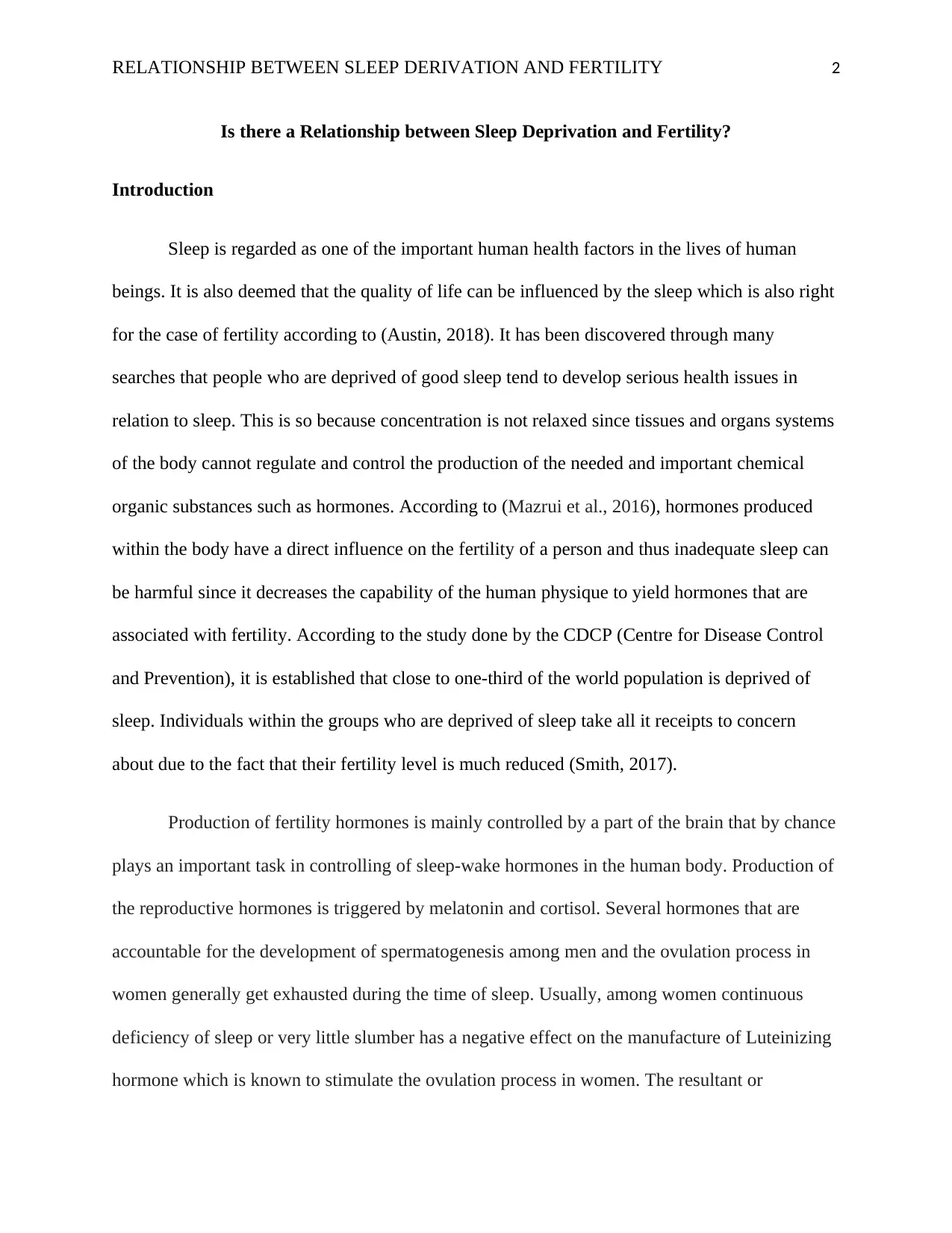
RELATIONSHIP BETWEEN SLEEP DERIVATION AND FERTILITY 2
Is there a Relationship between Sleep Deprivation and Fertility?
Introduction
Sleep is regarded as one of the important human health factors in the lives of human
beings. It is also deemed that the quality of life can be influenced by the sleep which is also right
for the case of fertility according to (Austin, 2018). It has been discovered through many
searches that people who are deprived of good sleep tend to develop serious health issues in
relation to sleep. This is so because concentration is not relaxed since tissues and organs systems
of the body cannot regulate and control the production of the needed and important chemical
organic substances such as hormones. According to (Mazrui et al., 2016), hormones produced
within the body have a direct influence on the fertility of a person and thus inadequate sleep can
be harmful since it decreases the capability of the human physique to yield hormones that are
associated with fertility. According to the study done by the CDCP (Centre for Disease Control
and Prevention), it is established that close to one-third of the world population is deprived of
sleep. Individuals within the groups who are deprived of sleep take all it receipts to concern
about due to the fact that their fertility level is much reduced (Smith, 2017).
Production of fertility hormones is mainly controlled by a part of the brain that by chance
plays an important task in controlling of sleep-wake hormones in the human body. Production of
the reproductive hormones is triggered by melatonin and cortisol. Several hormones that are
accountable for the development of spermatogenesis among men and the ovulation process in
women generally get exhausted during the time of sleep. Usually, among women continuous
deficiency of sleep or very little slumber has a negative effect on the manufacture of Luteinizing
hormone which is known to stimulate the ovulation process in women. The resultant or
Is there a Relationship between Sleep Deprivation and Fertility?
Introduction
Sleep is regarded as one of the important human health factors in the lives of human
beings. It is also deemed that the quality of life can be influenced by the sleep which is also right
for the case of fertility according to (Austin, 2018). It has been discovered through many
searches that people who are deprived of good sleep tend to develop serious health issues in
relation to sleep. This is so because concentration is not relaxed since tissues and organs systems
of the body cannot regulate and control the production of the needed and important chemical
organic substances such as hormones. According to (Mazrui et al., 2016), hormones produced
within the body have a direct influence on the fertility of a person and thus inadequate sleep can
be harmful since it decreases the capability of the human physique to yield hormones that are
associated with fertility. According to the study done by the CDCP (Centre for Disease Control
and Prevention), it is established that close to one-third of the world population is deprived of
sleep. Individuals within the groups who are deprived of sleep take all it receipts to concern
about due to the fact that their fertility level is much reduced (Smith, 2017).
Production of fertility hormones is mainly controlled by a part of the brain that by chance
plays an important task in controlling of sleep-wake hormones in the human body. Production of
the reproductive hormones is triggered by melatonin and cortisol. Several hormones that are
accountable for the development of spermatogenesis among men and the ovulation process in
women generally get exhausted during the time of sleep. Usually, among women continuous
deficiency of sleep or very little slumber has a negative effect on the manufacture of Luteinizing
hormone which is known to stimulate the ovulation process in women. The resultant or
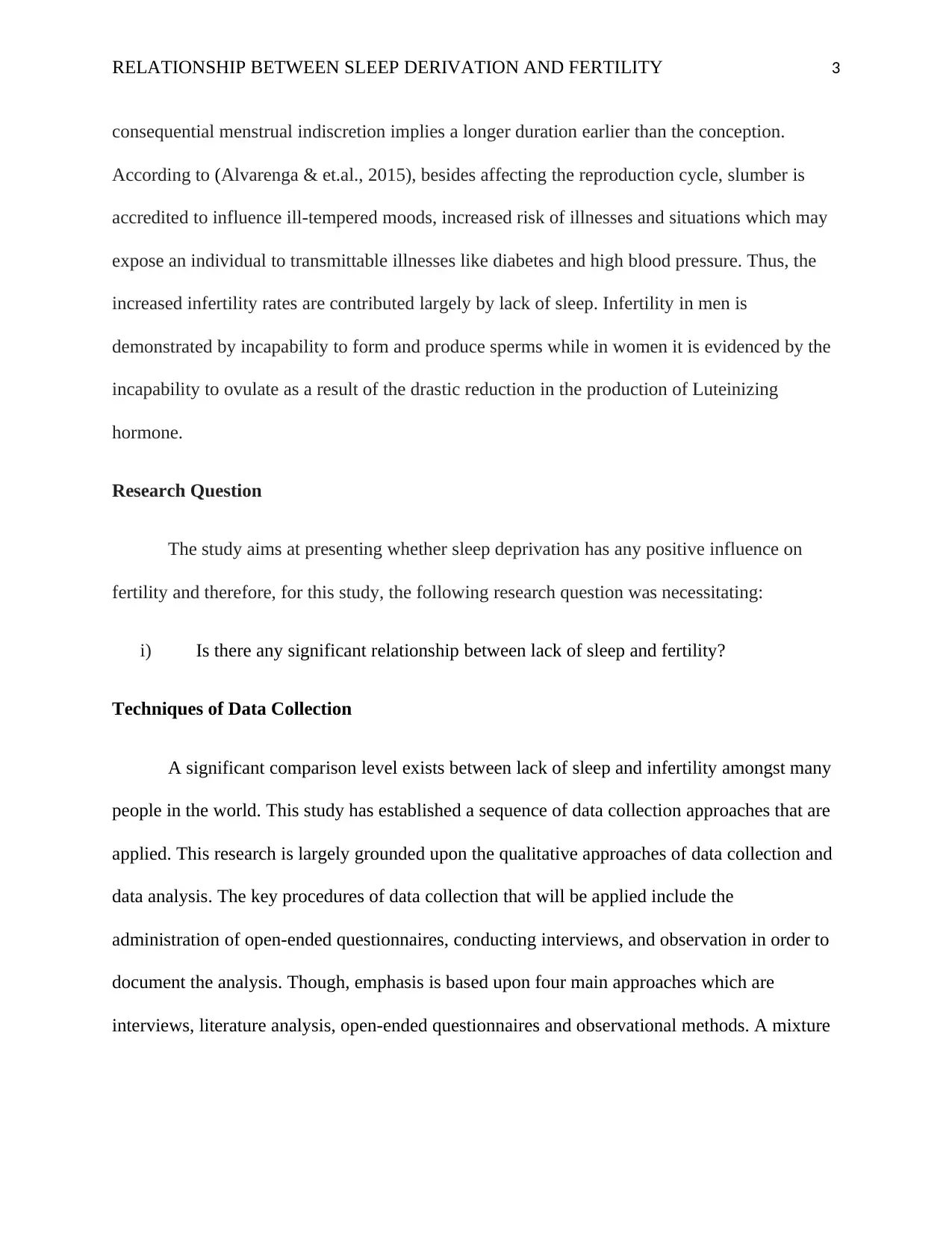
RELATIONSHIP BETWEEN SLEEP DERIVATION AND FERTILITY 3
consequential menstrual indiscretion implies a longer duration earlier than the conception.
According to (Alvarenga & et.al., 2015), besides affecting the reproduction cycle, slumber is
accredited to influence ill-tempered moods, increased risk of illnesses and situations which may
expose an individual to transmittable illnesses like diabetes and high blood pressure. Thus, the
increased infertility rates are contributed largely by lack of sleep. Infertility in men is
demonstrated by incapability to form and produce sperms while in women it is evidenced by the
incapability to ovulate as a result of the drastic reduction in the production of Luteinizing
hormone.
Research Question
The study aims at presenting whether sleep deprivation has any positive influence on
fertility and therefore, for this study, the following research question was necessitating:
i) Is there any significant relationship between lack of sleep and fertility?
Techniques of Data Collection
A significant comparison level exists between lack of sleep and infertility amongst many
people in the world. This study has established a sequence of data collection approaches that are
applied. This research is largely grounded upon the qualitative approaches of data collection and
data analysis. The key procedures of data collection that will be applied include the
administration of open-ended questionnaires, conducting interviews, and observation in order to
document the analysis. Though, emphasis is based upon four main approaches which are
interviews, literature analysis, open-ended questionnaires and observational methods. A mixture
consequential menstrual indiscretion implies a longer duration earlier than the conception.
According to (Alvarenga & et.al., 2015), besides affecting the reproduction cycle, slumber is
accredited to influence ill-tempered moods, increased risk of illnesses and situations which may
expose an individual to transmittable illnesses like diabetes and high blood pressure. Thus, the
increased infertility rates are contributed largely by lack of sleep. Infertility in men is
demonstrated by incapability to form and produce sperms while in women it is evidenced by the
incapability to ovulate as a result of the drastic reduction in the production of Luteinizing
hormone.
Research Question
The study aims at presenting whether sleep deprivation has any positive influence on
fertility and therefore, for this study, the following research question was necessitating:
i) Is there any significant relationship between lack of sleep and fertility?
Techniques of Data Collection
A significant comparison level exists between lack of sleep and infertility amongst many
people in the world. This study has established a sequence of data collection approaches that are
applied. This research is largely grounded upon the qualitative approaches of data collection and
data analysis. The key procedures of data collection that will be applied include the
administration of open-ended questionnaires, conducting interviews, and observation in order to
document the analysis. Though, emphasis is based upon four main approaches which are
interviews, literature analysis, open-ended questionnaires and observational methods. A mixture
⊘ This is a preview!⊘
Do you want full access?
Subscribe today to unlock all pages.

Trusted by 1+ million students worldwide
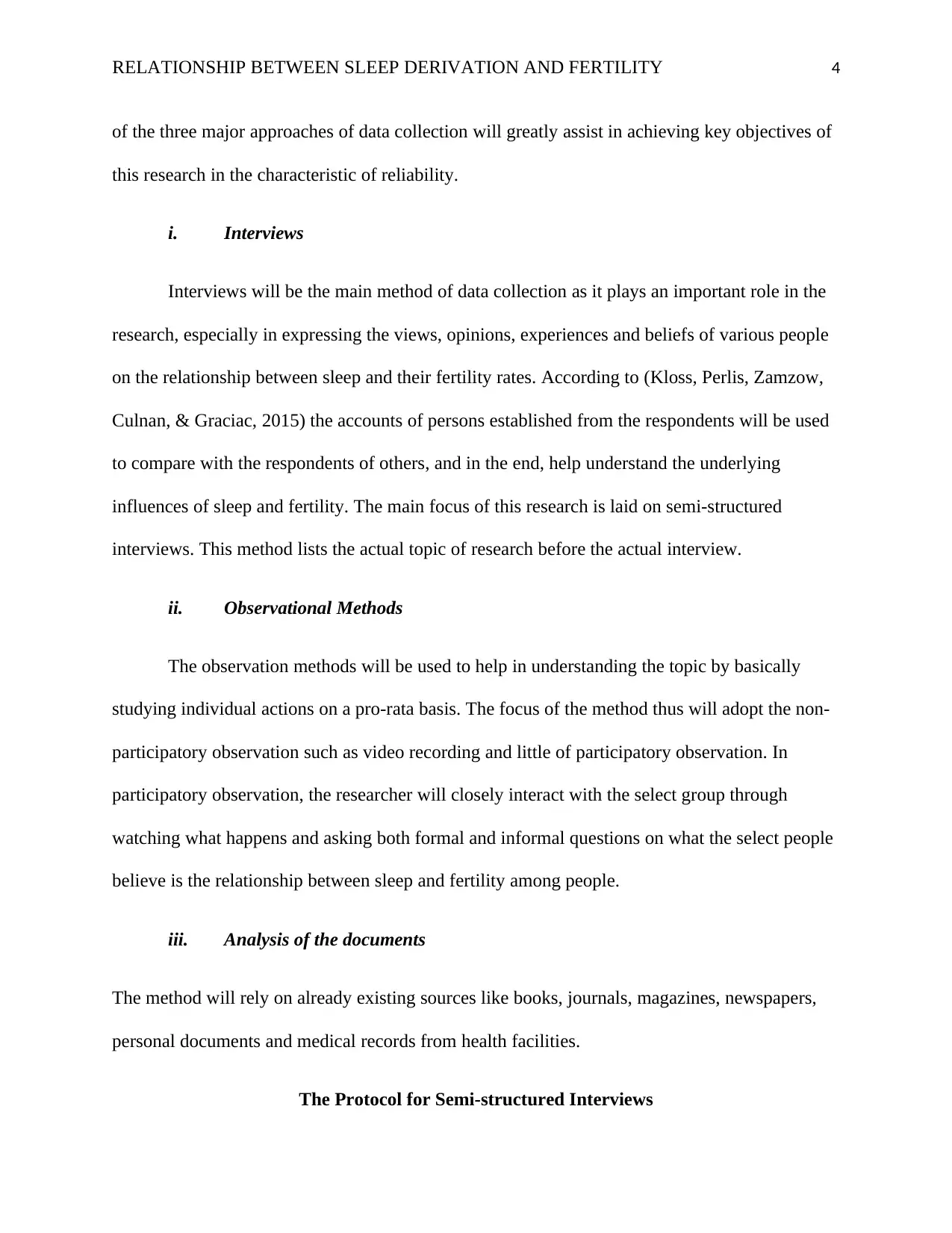
RELATIONSHIP BETWEEN SLEEP DERIVATION AND FERTILITY 4
of the three major approaches of data collection will greatly assist in achieving key objectives of
this research in the characteristic of reliability.
i. Interviews
Interviews will be the main method of data collection as it plays an important role in the
research, especially in expressing the views, opinions, experiences and beliefs of various people
on the relationship between sleep and their fertility rates. According to (Kloss, Perlis, Zamzow,
Culnan, & Graciac, 2015) the accounts of persons established from the respondents will be used
to compare with the respondents of others, and in the end, help understand the underlying
influences of sleep and fertility. The main focus of this research is laid on semi-structured
interviews. This method lists the actual topic of research before the actual interview.
ii. Observational Methods
The observation methods will be used to help in understanding the topic by basically
studying individual actions on a pro-rata basis. The focus of the method thus will adopt the non-
participatory observation such as video recording and little of participatory observation. In
participatory observation, the researcher will closely interact with the select group through
watching what happens and asking both formal and informal questions on what the select people
believe is the relationship between sleep and fertility among people.
iii. Analysis of the documents
The method will rely on already existing sources like books, journals, magazines, newspapers,
personal documents and medical records from health facilities.
The Protocol for Semi-structured Interviews
of the three major approaches of data collection will greatly assist in achieving key objectives of
this research in the characteristic of reliability.
i. Interviews
Interviews will be the main method of data collection as it plays an important role in the
research, especially in expressing the views, opinions, experiences and beliefs of various people
on the relationship between sleep and their fertility rates. According to (Kloss, Perlis, Zamzow,
Culnan, & Graciac, 2015) the accounts of persons established from the respondents will be used
to compare with the respondents of others, and in the end, help understand the underlying
influences of sleep and fertility. The main focus of this research is laid on semi-structured
interviews. This method lists the actual topic of research before the actual interview.
ii. Observational Methods
The observation methods will be used to help in understanding the topic by basically
studying individual actions on a pro-rata basis. The focus of the method thus will adopt the non-
participatory observation such as video recording and little of participatory observation. In
participatory observation, the researcher will closely interact with the select group through
watching what happens and asking both formal and informal questions on what the select people
believe is the relationship between sleep and fertility among people.
iii. Analysis of the documents
The method will rely on already existing sources like books, journals, magazines, newspapers,
personal documents and medical records from health facilities.
The Protocol for Semi-structured Interviews
Paraphrase This Document
Need a fresh take? Get an instant paraphrase of this document with our AI Paraphraser
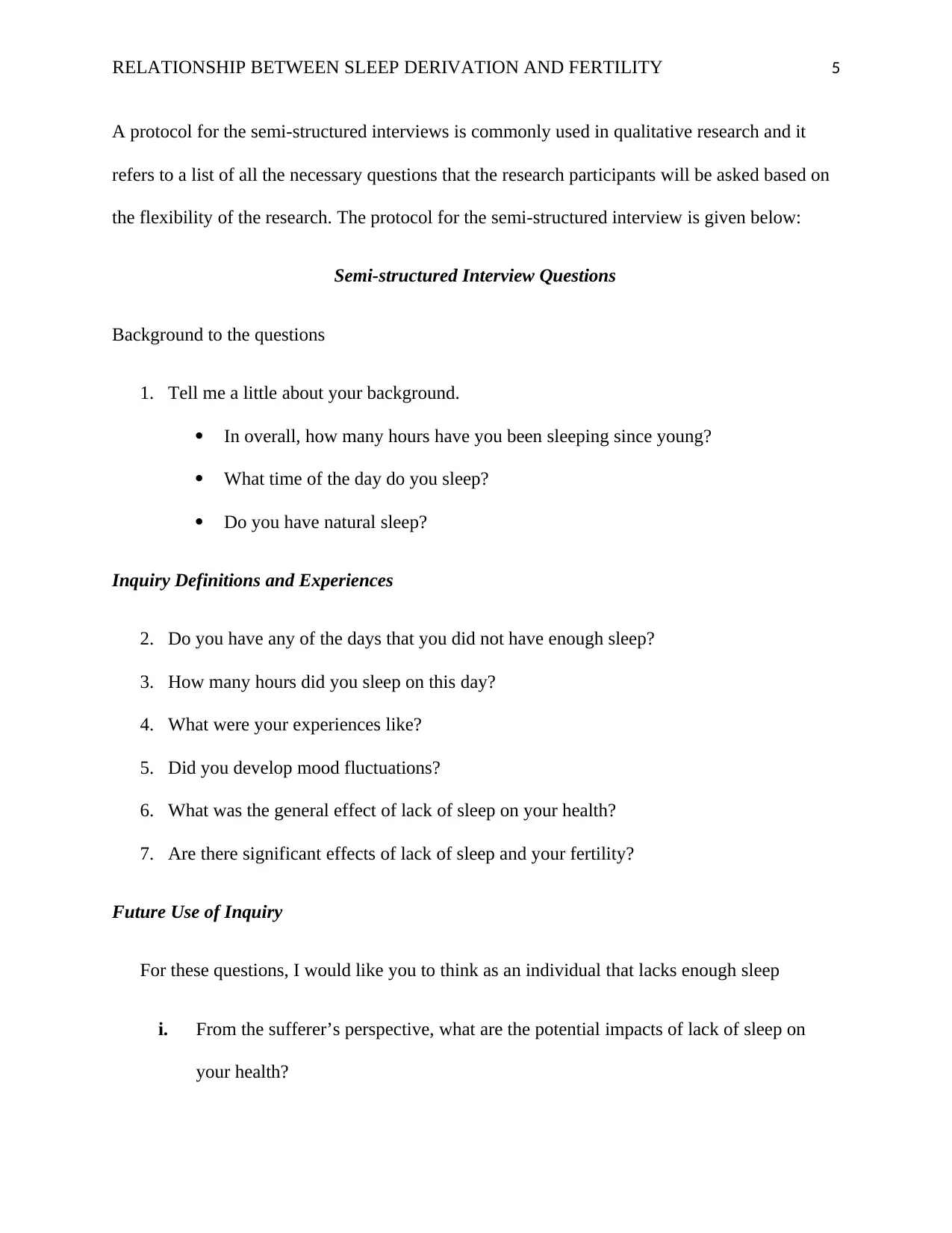
RELATIONSHIP BETWEEN SLEEP DERIVATION AND FERTILITY 5
A protocol for the semi-structured interviews is commonly used in qualitative research and it
refers to a list of all the necessary questions that the research participants will be asked based on
the flexibility of the research. The protocol for the semi-structured interview is given below:
Semi-structured Interview Questions
Background to the questions
1. Tell me a little about your background.
In overall, how many hours have you been sleeping since young?
What time of the day do you sleep?
Do you have natural sleep?
Inquiry Definitions and Experiences
2. Do you have any of the days that you did not have enough sleep?
3. How many hours did you sleep on this day?
4. What were your experiences like?
5. Did you develop mood fluctuations?
6. What was the general effect of lack of sleep on your health?
7. Are there significant effects of lack of sleep and your fertility?
Future Use of Inquiry
For these questions, I would like you to think as an individual that lacks enough sleep
i. From the sufferer’s perspective, what are the potential impacts of lack of sleep on
your health?
A protocol for the semi-structured interviews is commonly used in qualitative research and it
refers to a list of all the necessary questions that the research participants will be asked based on
the flexibility of the research. The protocol for the semi-structured interview is given below:
Semi-structured Interview Questions
Background to the questions
1. Tell me a little about your background.
In overall, how many hours have you been sleeping since young?
What time of the day do you sleep?
Do you have natural sleep?
Inquiry Definitions and Experiences
2. Do you have any of the days that you did not have enough sleep?
3. How many hours did you sleep on this day?
4. What were your experiences like?
5. Did you develop mood fluctuations?
6. What was the general effect of lack of sleep on your health?
7. Are there significant effects of lack of sleep and your fertility?
Future Use of Inquiry
For these questions, I would like you to think as an individual that lacks enough sleep
i. From the sufferer’s perspective, what are the potential impacts of lack of sleep on
your health?
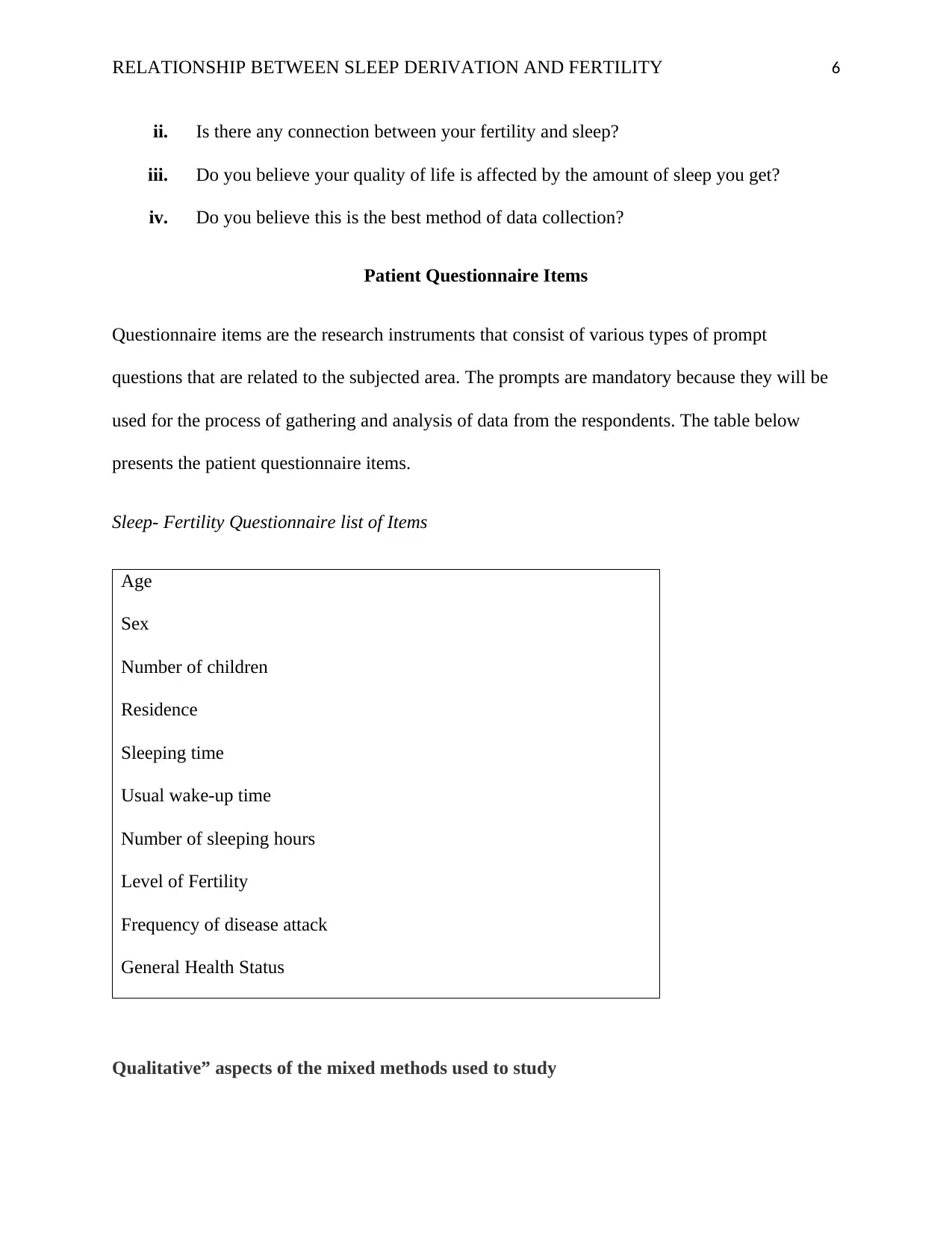
RELATIONSHIP BETWEEN SLEEP DERIVATION AND FERTILITY 6
ii. Is there any connection between your fertility and sleep?
iii. Do you believe your quality of life is affected by the amount of sleep you get?
iv. Do you believe this is the best method of data collection?
Patient Questionnaire Items
Questionnaire items are the research instruments that consist of various types of prompt
questions that are related to the subjected area. The prompts are mandatory because they will be
used for the process of gathering and analysis of data from the respondents. The table below
presents the patient questionnaire items.
Sleep- Fertility Questionnaire list of Items
Age
Sex
Number of children
Residence
Sleeping time
Usual wake-up time
Number of sleeping hours
Level of Fertility
Frequency of disease attack
General Health Status
Qualitative” aspects of the mixed methods used to study
ii. Is there any connection between your fertility and sleep?
iii. Do you believe your quality of life is affected by the amount of sleep you get?
iv. Do you believe this is the best method of data collection?
Patient Questionnaire Items
Questionnaire items are the research instruments that consist of various types of prompt
questions that are related to the subjected area. The prompts are mandatory because they will be
used for the process of gathering and analysis of data from the respondents. The table below
presents the patient questionnaire items.
Sleep- Fertility Questionnaire list of Items
Age
Sex
Number of children
Residence
Sleeping time
Usual wake-up time
Number of sleeping hours
Level of Fertility
Frequency of disease attack
General Health Status
Qualitative” aspects of the mixed methods used to study
⊘ This is a preview!⊘
Do you want full access?
Subscribe today to unlock all pages.

Trusted by 1+ million students worldwide
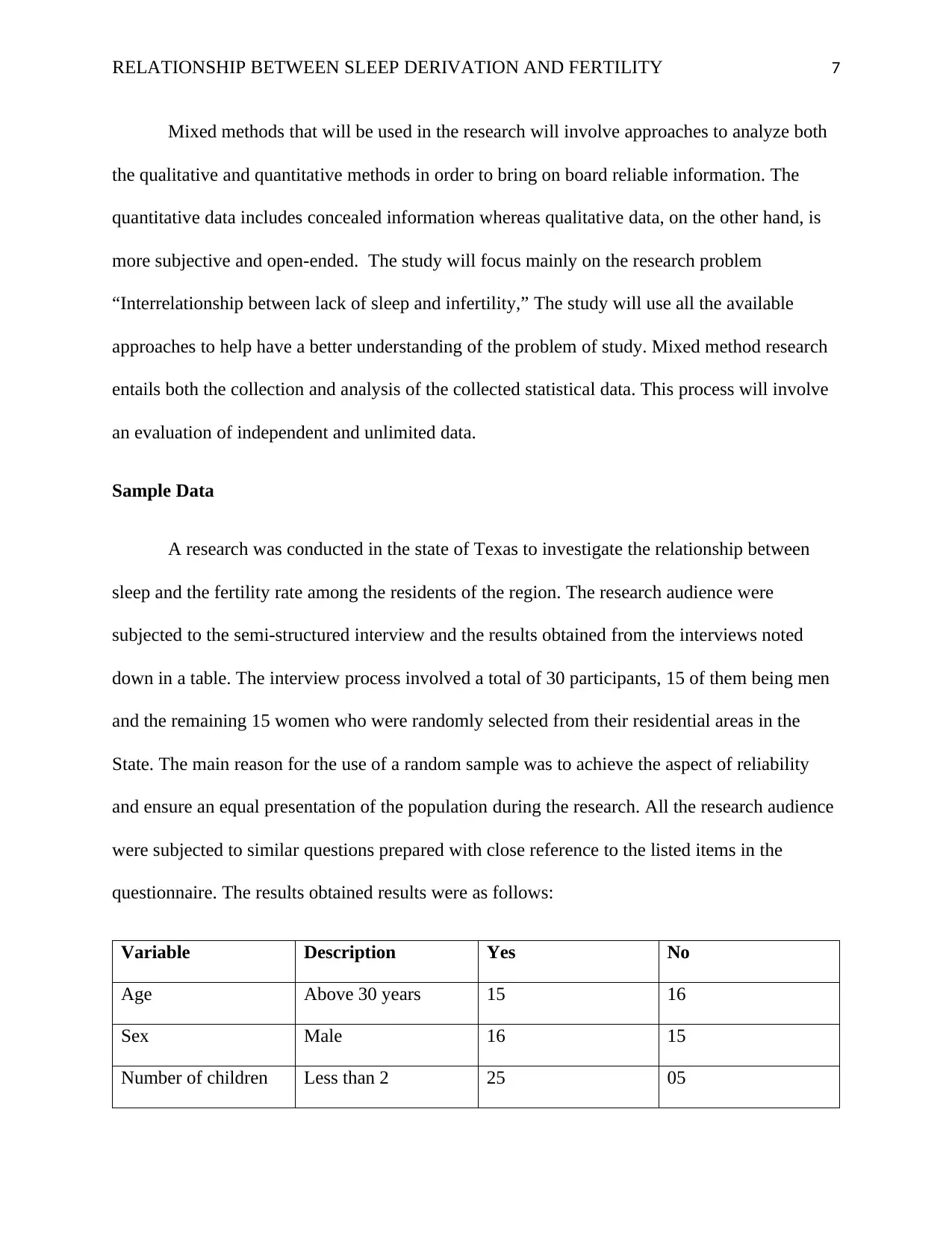
RELATIONSHIP BETWEEN SLEEP DERIVATION AND FERTILITY 7
Mixed methods that will be used in the research will involve approaches to analyze both
the qualitative and quantitative methods in order to bring on board reliable information. The
quantitative data includes concealed information whereas qualitative data, on the other hand, is
more subjective and open-ended. The study will focus mainly on the research problem
“Interrelationship between lack of sleep and infertility,” The study will use all the available
approaches to help have a better understanding of the problem of study. Mixed method research
entails both the collection and analysis of the collected statistical data. This process will involve
an evaluation of independent and unlimited data.
Sample Data
A research was conducted in the state of Texas to investigate the relationship between
sleep and the fertility rate among the residents of the region. The research audience were
subjected to the semi-structured interview and the results obtained from the interviews noted
down in a table. The interview process involved a total of 30 participants, 15 of them being men
and the remaining 15 women who were randomly selected from their residential areas in the
State. The main reason for the use of a random sample was to achieve the aspect of reliability
and ensure an equal presentation of the population during the research. All the research audience
were subjected to similar questions prepared with close reference to the listed items in the
questionnaire. The results obtained results were as follows:
Variable Description Yes No
Age Above 30 years 15 16
Sex Male 16 15
Number of children Less than 2 25 05
Mixed methods that will be used in the research will involve approaches to analyze both
the qualitative and quantitative methods in order to bring on board reliable information. The
quantitative data includes concealed information whereas qualitative data, on the other hand, is
more subjective and open-ended. The study will focus mainly on the research problem
“Interrelationship between lack of sleep and infertility,” The study will use all the available
approaches to help have a better understanding of the problem of study. Mixed method research
entails both the collection and analysis of the collected statistical data. This process will involve
an evaluation of independent and unlimited data.
Sample Data
A research was conducted in the state of Texas to investigate the relationship between
sleep and the fertility rate among the residents of the region. The research audience were
subjected to the semi-structured interview and the results obtained from the interviews noted
down in a table. The interview process involved a total of 30 participants, 15 of them being men
and the remaining 15 women who were randomly selected from their residential areas in the
State. The main reason for the use of a random sample was to achieve the aspect of reliability
and ensure an equal presentation of the population during the research. All the research audience
were subjected to similar questions prepared with close reference to the listed items in the
questionnaire. The results obtained results were as follows:
Variable Description Yes No
Age Above 30 years 15 16
Sex Male 16 15
Number of children Less than 2 25 05
Paraphrase This Document
Need a fresh take? Get an instant paraphrase of this document with our AI Paraphraser
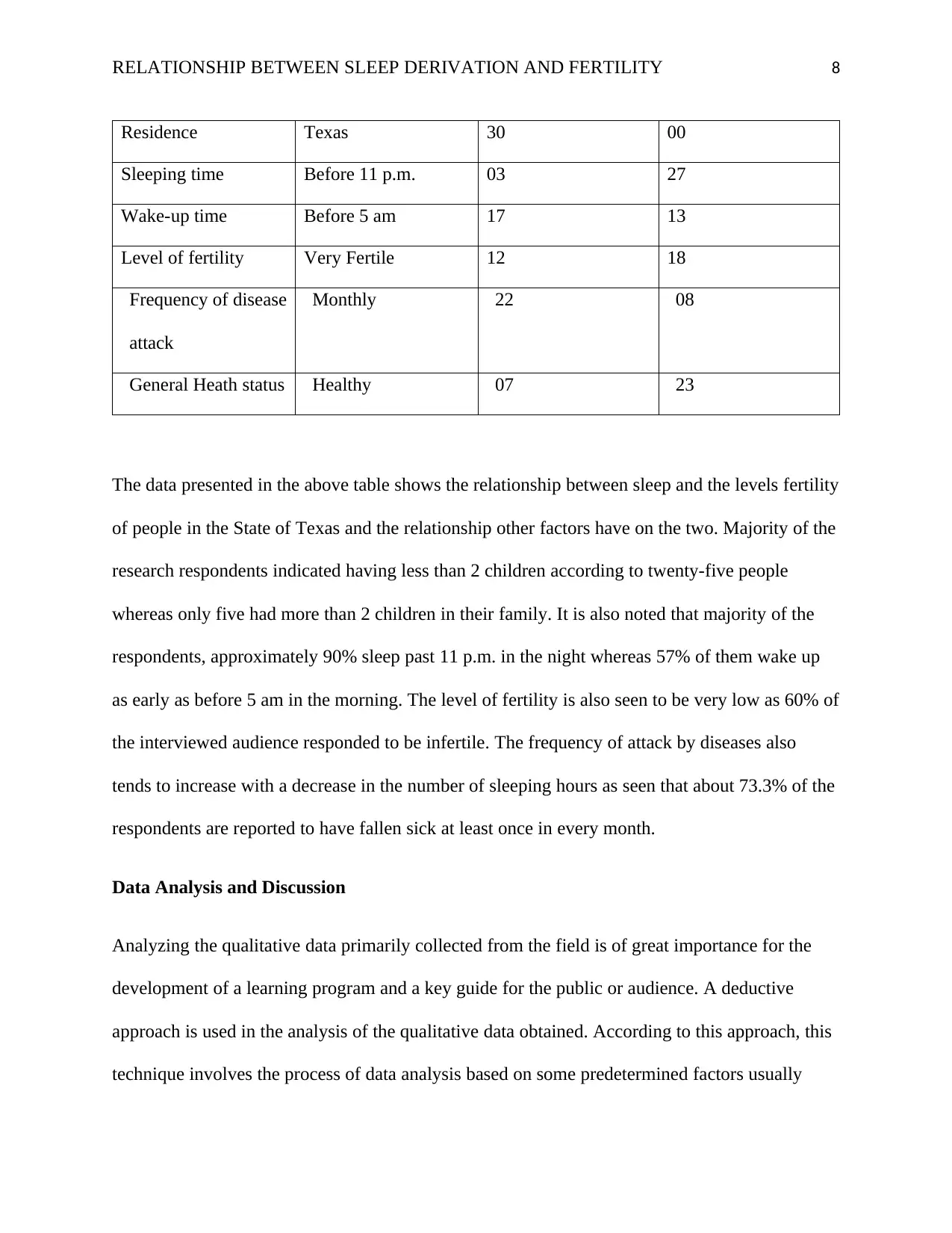
RELATIONSHIP BETWEEN SLEEP DERIVATION AND FERTILITY 8
Residence Texas 30 00
Sleeping time Before 11 p.m. 03 27
Wake-up time Before 5 am 17 13
Level of fertility Very Fertile 12 18
Frequency of disease
attack
Monthly 22 08
General Heath status Healthy 07 23
The data presented in the above table shows the relationship between sleep and the levels fertility
of people in the State of Texas and the relationship other factors have on the two. Majority of the
research respondents indicated having less than 2 children according to twenty-five people
whereas only five had more than 2 children in their family. It is also noted that majority of the
respondents, approximately 90% sleep past 11 p.m. in the night whereas 57% of them wake up
as early as before 5 am in the morning. The level of fertility is also seen to be very low as 60% of
the interviewed audience responded to be infertile. The frequency of attack by diseases also
tends to increase with a decrease in the number of sleeping hours as seen that about 73.3% of the
respondents are reported to have fallen sick at least once in every month.
Data Analysis and Discussion
Analyzing the qualitative data primarily collected from the field is of great importance for the
development of a learning program and a key guide for the public or audience. A deductive
approach is used in the analysis of the qualitative data obtained. According to this approach, this
technique involves the process of data analysis based on some predetermined factors usually
Residence Texas 30 00
Sleeping time Before 11 p.m. 03 27
Wake-up time Before 5 am 17 13
Level of fertility Very Fertile 12 18
Frequency of disease
attack
Monthly 22 08
General Heath status Healthy 07 23
The data presented in the above table shows the relationship between sleep and the levels fertility
of people in the State of Texas and the relationship other factors have on the two. Majority of the
research respondents indicated having less than 2 children according to twenty-five people
whereas only five had more than 2 children in their family. It is also noted that majority of the
respondents, approximately 90% sleep past 11 p.m. in the night whereas 57% of them wake up
as early as before 5 am in the morning. The level of fertility is also seen to be very low as 60% of
the interviewed audience responded to be infertile. The frequency of attack by diseases also
tends to increase with a decrease in the number of sleeping hours as seen that about 73.3% of the
respondents are reported to have fallen sick at least once in every month.
Data Analysis and Discussion
Analyzing the qualitative data primarily collected from the field is of great importance for the
development of a learning program and a key guide for the public or audience. A deductive
approach is used in the analysis of the qualitative data obtained. According to this approach, this
technique involves the process of data analysis based on some predetermined factors usually
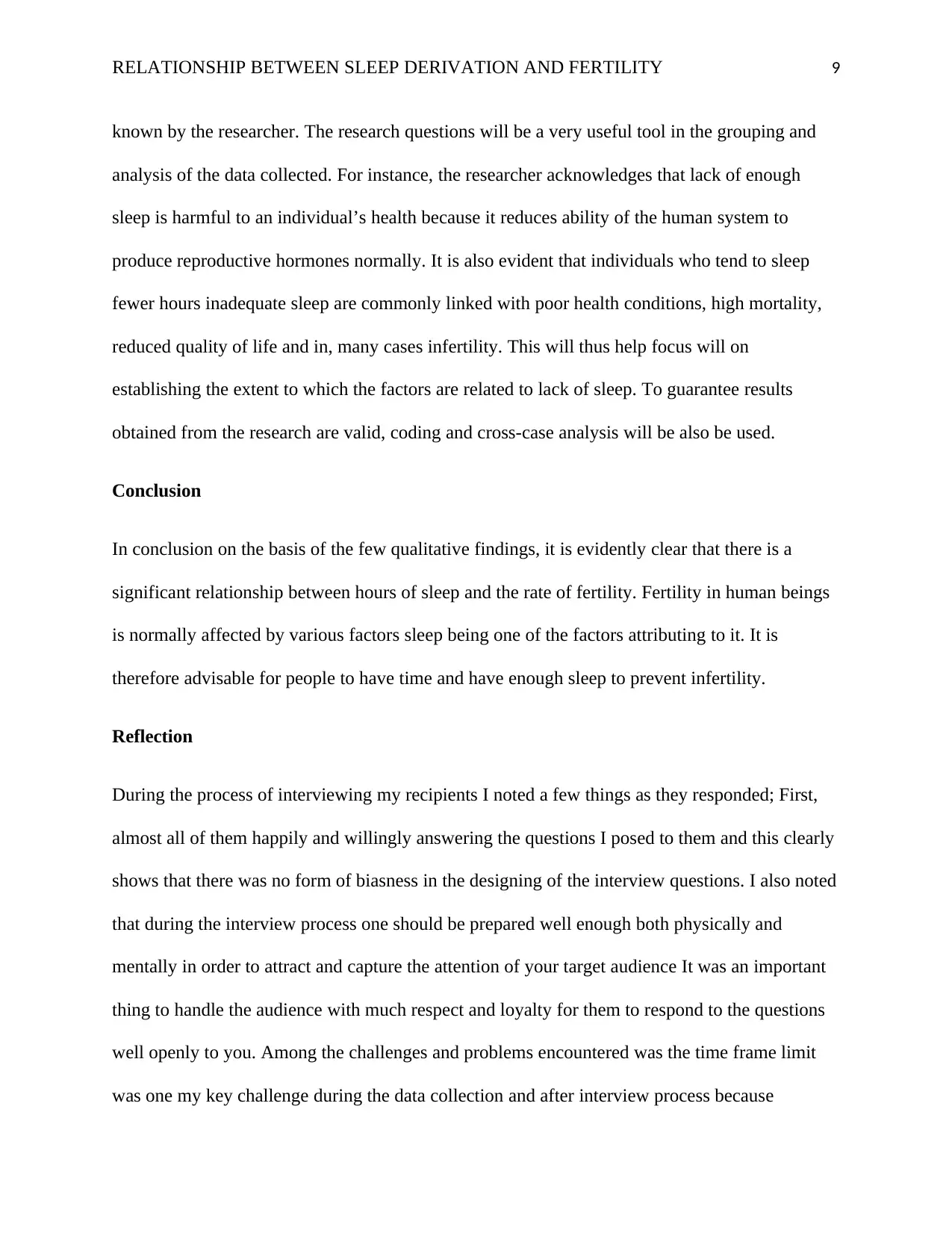
RELATIONSHIP BETWEEN SLEEP DERIVATION AND FERTILITY 9
known by the researcher. The research questions will be a very useful tool in the grouping and
analysis of the data collected. For instance, the researcher acknowledges that lack of enough
sleep is harmful to an individual’s health because it reduces ability of the human system to
produce reproductive hormones normally. It is also evident that individuals who tend to sleep
fewer hours inadequate sleep are commonly linked with poor health conditions, high mortality,
reduced quality of life and in, many cases infertility. This will thus help focus will on
establishing the extent to which the factors are related to lack of sleep. To guarantee results
obtained from the research are valid, coding and cross-case analysis will be also be used.
Conclusion
In conclusion on the basis of the few qualitative findings, it is evidently clear that there is a
significant relationship between hours of sleep and the rate of fertility. Fertility in human beings
is normally affected by various factors sleep being one of the factors attributing to it. It is
therefore advisable for people to have time and have enough sleep to prevent infertility.
Reflection
During the process of interviewing my recipients I noted a few things as they responded; First,
almost all of them happily and willingly answering the questions I posed to them and this clearly
shows that there was no form of biasness in the designing of the interview questions. I also noted
that during the interview process one should be prepared well enough both physically and
mentally in order to attract and capture the attention of your target audience It was an important
thing to handle the audience with much respect and loyalty for them to respond to the questions
well openly to you. Among the challenges and problems encountered was the time frame limit
was one my key challenge during the data collection and after interview process because
known by the researcher. The research questions will be a very useful tool in the grouping and
analysis of the data collected. For instance, the researcher acknowledges that lack of enough
sleep is harmful to an individual’s health because it reduces ability of the human system to
produce reproductive hormones normally. It is also evident that individuals who tend to sleep
fewer hours inadequate sleep are commonly linked with poor health conditions, high mortality,
reduced quality of life and in, many cases infertility. This will thus help focus will on
establishing the extent to which the factors are related to lack of sleep. To guarantee results
obtained from the research are valid, coding and cross-case analysis will be also be used.
Conclusion
In conclusion on the basis of the few qualitative findings, it is evidently clear that there is a
significant relationship between hours of sleep and the rate of fertility. Fertility in human beings
is normally affected by various factors sleep being one of the factors attributing to it. It is
therefore advisable for people to have time and have enough sleep to prevent infertility.
Reflection
During the process of interviewing my recipients I noted a few things as they responded; First,
almost all of them happily and willingly answering the questions I posed to them and this clearly
shows that there was no form of biasness in the designing of the interview questions. I also noted
that during the interview process one should be prepared well enough both physically and
mentally in order to attract and capture the attention of your target audience It was an important
thing to handle the audience with much respect and loyalty for them to respond to the questions
well openly to you. Among the challenges and problems encountered was the time frame limit
was one my key challenge during the data collection and after interview process because
⊘ This is a preview!⊘
Do you want full access?
Subscribe today to unlock all pages.

Trusted by 1+ million students worldwide
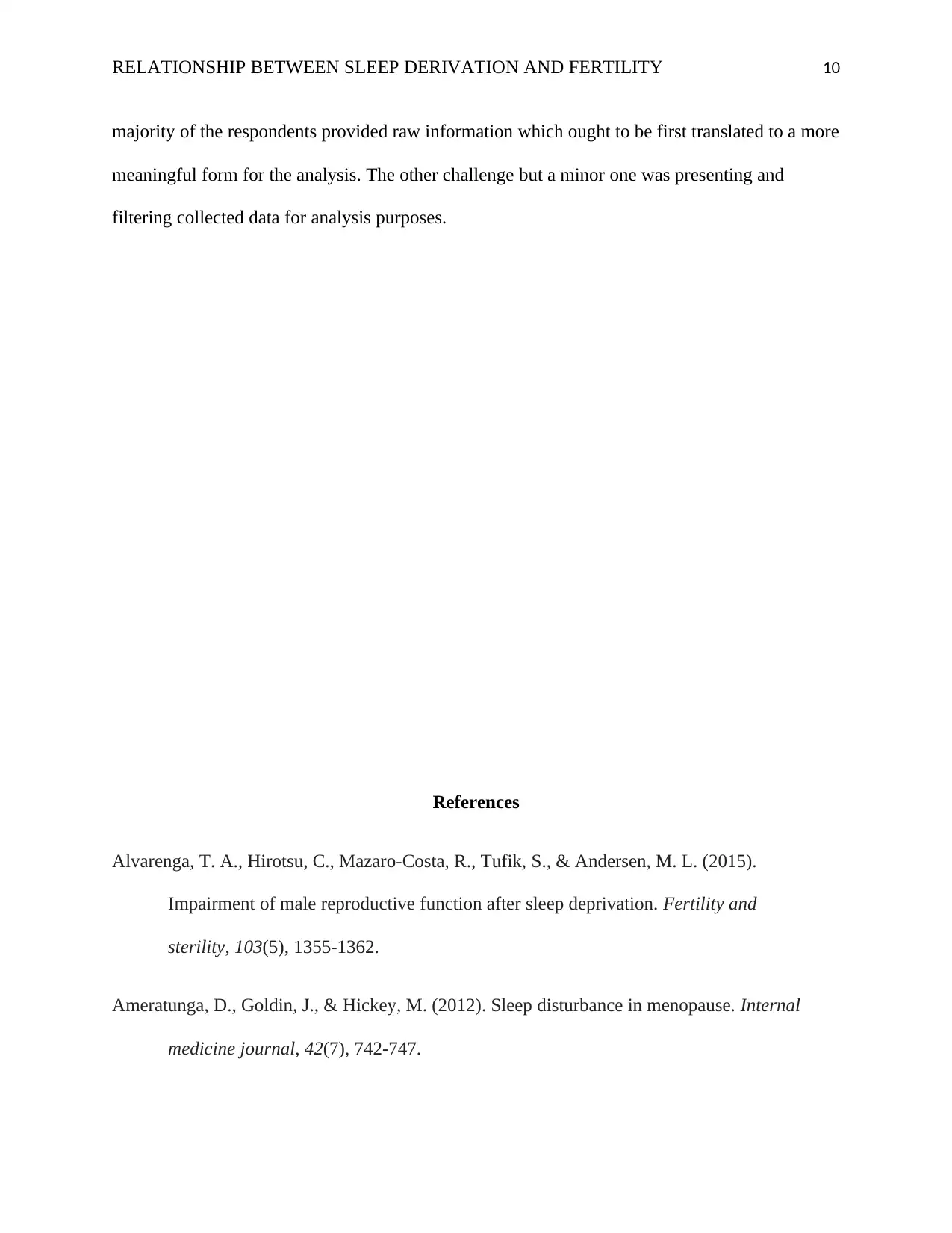
RELATIONSHIP BETWEEN SLEEP DERIVATION AND FERTILITY 10
majority of the respondents provided raw information which ought to be first translated to a more
meaningful form for the analysis. The other challenge but a minor one was presenting and
filtering collected data for analysis purposes.
References
Alvarenga, T. A., Hirotsu, C., Mazaro-Costa, R., Tufik, S., & Andersen, M. L. (2015).
Impairment of male reproductive function after sleep deprivation. Fertility and
sterility, 103(5), 1355-1362.
Ameratunga, D., Goldin, J., & Hickey, M. (2012). Sleep disturbance in menopause. Internal
medicine journal, 42(7), 742-747.
majority of the respondents provided raw information which ought to be first translated to a more
meaningful form for the analysis. The other challenge but a minor one was presenting and
filtering collected data for analysis purposes.
References
Alvarenga, T. A., Hirotsu, C., Mazaro-Costa, R., Tufik, S., & Andersen, M. L. (2015).
Impairment of male reproductive function after sleep deprivation. Fertility and
sterility, 103(5), 1355-1362.
Ameratunga, D., Goldin, J., & Hickey, M. (2012). Sleep disturbance in menopause. Internal
medicine journal, 42(7), 742-747.
Paraphrase This Document
Need a fresh take? Get an instant paraphrase of this document with our AI Paraphraser
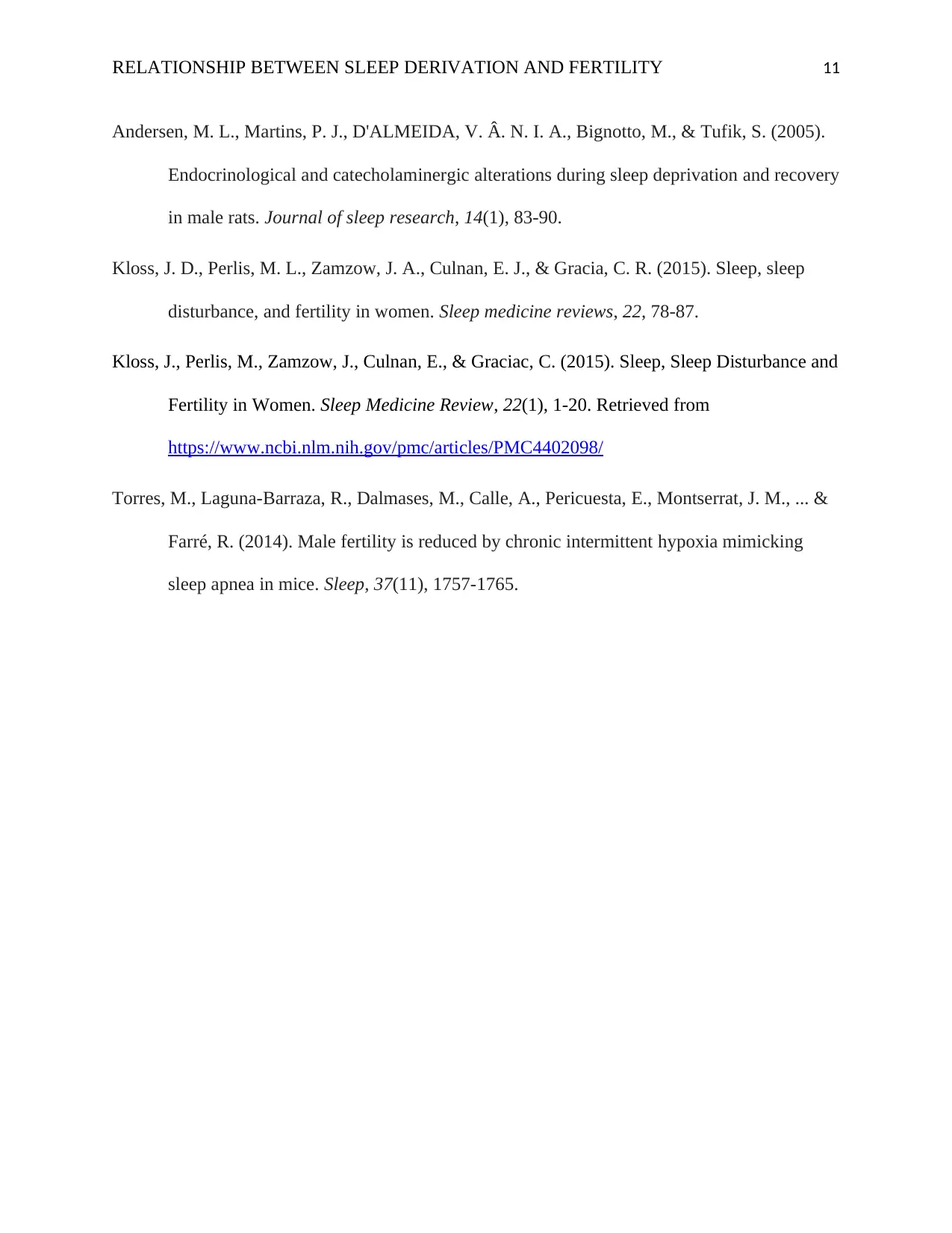
RELATIONSHIP BETWEEN SLEEP DERIVATION AND FERTILITY 11
Andersen, M. L., Martins, P. J., D'ALMEIDA, V. Â. N. I. A., Bignotto, M., & Tufik, S. (2005).
Endocrinological and catecholaminergic alterations during sleep deprivation and recovery
in male rats. Journal of sleep research, 14(1), 83-90.
Kloss, J. D., Perlis, M. L., Zamzow, J. A., Culnan, E. J., & Gracia, C. R. (2015). Sleep, sleep
disturbance, and fertility in women. Sleep medicine reviews, 22, 78-87.
Kloss, J., Perlis, M., Zamzow, J., Culnan, E., & Graciac, C. (2015). Sleep, Sleep Disturbance and
Fertility in Women. Sleep Medicine Review, 22(1), 1-20. Retrieved from
https://www.ncbi.nlm.nih.gov/pmc/articles/PMC4402098/
Torres, M., Laguna-Barraza, R., Dalmases, M., Calle, A., Pericuesta, E., Montserrat, J. M., ... &
Farré, R. (2014). Male fertility is reduced by chronic intermittent hypoxia mimicking
sleep apnea in mice. Sleep, 37(11), 1757-1765.
Andersen, M. L., Martins, P. J., D'ALMEIDA, V. Â. N. I. A., Bignotto, M., & Tufik, S. (2005).
Endocrinological and catecholaminergic alterations during sleep deprivation and recovery
in male rats. Journal of sleep research, 14(1), 83-90.
Kloss, J. D., Perlis, M. L., Zamzow, J. A., Culnan, E. J., & Gracia, C. R. (2015). Sleep, sleep
disturbance, and fertility in women. Sleep medicine reviews, 22, 78-87.
Kloss, J., Perlis, M., Zamzow, J., Culnan, E., & Graciac, C. (2015). Sleep, Sleep Disturbance and
Fertility in Women. Sleep Medicine Review, 22(1), 1-20. Retrieved from
https://www.ncbi.nlm.nih.gov/pmc/articles/PMC4402098/
Torres, M., Laguna-Barraza, R., Dalmases, M., Calle, A., Pericuesta, E., Montserrat, J. M., ... &
Farré, R. (2014). Male fertility is reduced by chronic intermittent hypoxia mimicking
sleep apnea in mice. Sleep, 37(11), 1757-1765.
1 out of 11
Your All-in-One AI-Powered Toolkit for Academic Success.
+13062052269
info@desklib.com
Available 24*7 on WhatsApp / Email
![[object Object]](/_next/static/media/star-bottom.7253800d.svg)
Unlock your academic potential
Copyright © 2020–2025 A2Z Services. All Rights Reserved. Developed and managed by ZUCOL.

